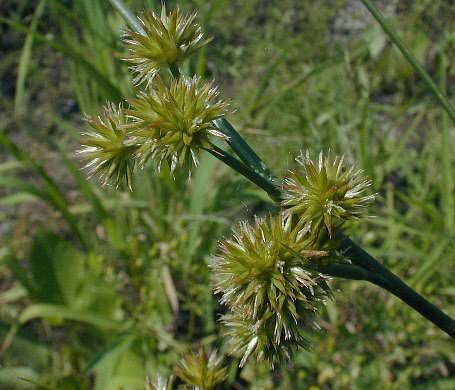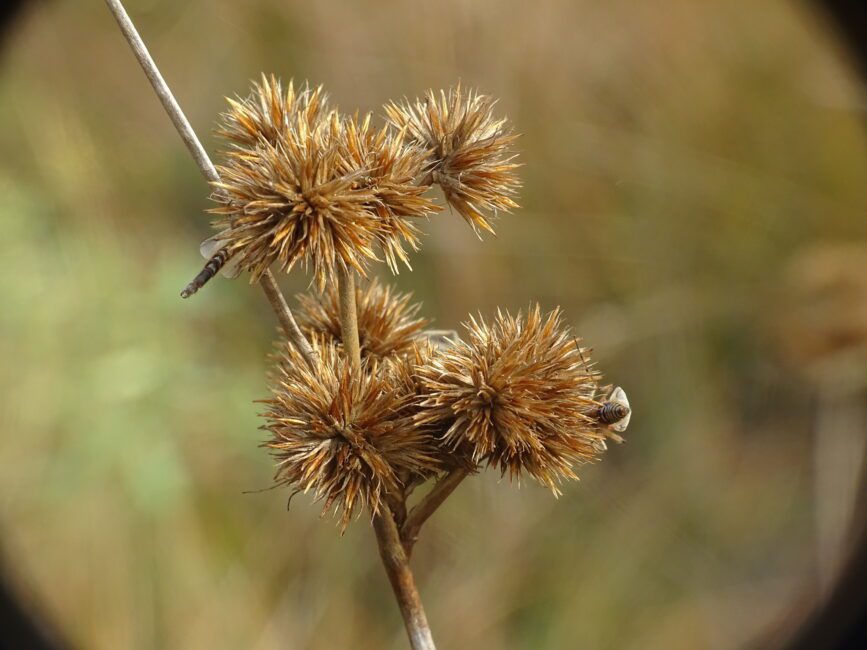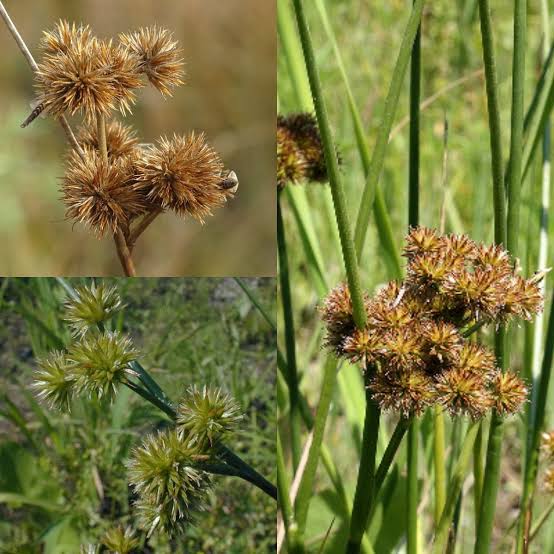Torrey’s rush (Juncus torreyi) is a special kind of plant. It grows in wet places, like marshes and damp meadows. This rush has long, slender leaves that stand tall and straight. The color of these leaves can vary, ranging from green to brown.
In the summer, Torrey’s rush produces tiny flowers that cluster together at the top. These flowers may be small, but they play a big role in the rush’s life. They attract insects, like bees, which help in the pollination process. Pollination is important for the rush to make seeds and continue its life cycle.
One interesting thing about Torrey’s rush is its ability to tolerate different soil types. Whether the soil is sandy or more on the clay side, this rush can adapt and thrive. It’s like a versatile friend to the environment, making it a valuable part of wetland ecosystems.
As a member of the Juncus family, Torrey’s rush contributes to the overall biodiversity of its habitat. It provides shelter for small creatures and adds to the beauty of wetland landscapes. The rush also assists in preventing soil erosion, acting like a natural anchor with its roots firmly planted in the ground.
Torrey’s rush has a slow and steady growth pattern. It takes its time to establish itself in its chosen wetland home. Over the years, it forms colonies, creating patches of greenery that contribute to the overall health of the ecosystem.
Torrey’s rush, with its simple yet elegant appearance, is a vital part of wetland environments. From its slender leaves to its tiny flowers, this rush plays a crucial role in supporting the biodiversity of its habitat.
Its adaptability, slow growth, and environmental contributions make it a noteworthy member of the plant kingdom.
Read Also: Bane berry Flowers (Actaea spicata): All You Need to Know About
How To Grow Torrey’s Rush (Juncus torreyi)

Growing Torrey’s rush (Juncus torreyi) can be a rewarding experience. Here’s a simple guide to help you cultivate this unique plant:
1. Choose the Right Location: Torrey’s rush thrives in wet conditions, so select a planting site with well-draining soil that retains moisture. Ideal locations include marshy areas, wet meadows, or gardens with consistent access to water.
2. Obtain Seeds or Plants: You can start Torrey’s rush from seeds or acquire young plants from a reputable nursery. If using seeds, ensure they are fresh and viable.
3. Planting Seeds: Scatter the seeds over the prepared soil surface in early spring or fall.
Gently press the seeds into the soil without covering them entirely, as they require light to germinate. Keep the soil consistently moist until the seeds sprout, which may take a few weeks.
4. Transplanting Young Plants: If starting with young plants, dig a hole in the moist soil that is large enough to accommodate the root system. Place the young Torrey’s rush plant in the hole, covering the roots with soil.
Water the plant thoroughly after transplanting to help it establish in its new location.
5. Watering: Torrey’s rush appreciates consistently moist soil, so water regularly, especially during dry periods. Avoid waterlogging, as excessive water can harm the plant.
6. Sunlight: While Torrey’s rush can tolerate partial shade, it generally prefers full sun. Ensure that the planting site receives an adequate amount of sunlight each day.
7. Maintenance: Torrey’s rush is a relatively low-maintenance plant. Remove any weeds that may compete for nutrients and water.
Mulching around the base of the plant can help retain moisture and suppress weeds.
8. Fertilization: Torrey’s rush typically doesn’t require frequent fertilization. However, if the soil is poor, you can apply a balanced, slow-release fertilizer in the spring.
9. Propagation: Torrey’s rush can be propagated by division. As the plant matures, you can divide the clumps and replant them in other suitable locations.
10. Enjoy and Observe: Once established, Torrey’s rush will grow and contribute to the natural beauty of your wetland or garden. Take time to observe its unique features and the wildlife it attracts.
Remember to consider local regulations and environmental guidelines when introducing Torrey’s rush to a new area, especially if it is a native plant in your region.
How To Care For Torrey’s Rush (Juncus torreyi)
Caring for Torrey’s rush (Juncus torreyi) involves providing the right conditions to support its growth and maintaining its well-being. Here’s a simple guide on how to care for this unique plant:
1. Watering: Torrey’s rush thrives in consistently moist soil. Regular watering is essential, especially during dry periods. Ensure the soil remains damp but not waterlogged.
2. Sunlight: While Torrey’s rush can tolerate partial shade, it generally prefers full sun. Ensure the plant receives an adequate amount of sunlight each day to promote healthy growth.
3. Soil Conditions: Plant Torrey’s rush in well-draining soil that retains moisture. The soil should be slightly acidic to neutral. Consider amending the soil with organic matter to enhance its fertility.
4. Mulching: Applying a layer of mulch around the base of Torrey’s rush can help retain soil moisture, suppress weeds, and regulate temperature. Use organic mulch such as straw or bark.
5. Weeding: Keep the area around Torrey’s rush free from competing weeds. Weeds can absorb water and nutrients that are essential for the rush’s growth.
6. Fertilization: Torrey’s rush generally doesn’t require frequent fertilization. If the soil is poor, you can apply a balanced, slow-release fertilizer in the spring. Avoid excessive fertilization, as this rush is adapted to nutrient-poor environments.
7. Pruning: Torrey’s rush is a relatively low-maintenance plant and doesn’t require extensive pruning. However, removing dead or damaged foliage can help maintain the plant’s overall health and appearance.
8. Division: As Torrey’s rush matures, you may consider dividing the clumps to propagate new plants. This can rejuvenate the plant and allow you to expand its presence in your garden or wetland area.
9. Pest and Disease Management: Torrey’s rush is generally resistant to many pests and diseases. Keep an eye out for any signs of stress or infestation, and address issues promptly. In most cases, a healthy plant is better equipped to resist pests and diseases.
Observation:
Take time to observe the growth and behavior of Torrey’s rush. This can help you identify any specific needs or issues that may arise, allowing you to adjust your care accordingly.
By providing consistent moisture, sunlight, and suitable soil conditions, and by addressing the plant’s minimal maintenance needs, you can ensure that Torrey’s rush thrives and contributes to the beauty of its environment.
Read Also: Basket of Gold Flowers – All You Need to Know About
The Uses of Torrey’s Rush (Juncus torreyi)

Torrey’s rush (Juncus torreyi) serves various ecological roles, and while it may not have extensive direct uses for humans, it plays a crucial part in supporting the natural environment. Here are some key uses and contributions of Torrey’s rush:
1. Erosion Control: The extensive root system of Torrey’s rush helps stabilize soil, making it effective for preventing erosion along water bodies and wetland areas.
2. Habitat for Wildlife: Torrey’s rush provides a habitat for various wildlife, including insects, birds, and small mammals. The dense clumps offer shelter, nesting sites, and protection for these creatures.
3. Biodiversity Support: As a native plant, Torrey’s rush contributes to the overall biodiversity of its habitat. It forms a part of the intricate web of plant and animal interactions in wetland ecosystems.
4. Water Filtration: Wetland plants, including Torrey’s rush, play a role in water filtration by absorbing nutrients and trapping sediments. This helps maintain water quality in aquatic environments.
5. Aesthetic Value: Torrey’s rush adds to the aesthetic appeal of wetland landscapes with its slender, upright growth habit. It contributes to the natural beauty of marshes, meadows, and other water-rich areas.
6. Educational Purposes: Studying Torrey’s rush can provide valuable insights into wetland ecology. It serves as an educational resource, helping individuals learn about the importance of native plants in maintaining healthy ecosystems.
7. Research Interest: Botanists and ecologists may study Torrey’s rush to understand its role in wetland ecosystems and its adaptations to different environmental conditions.
8. Soil Improvement: The decomposition of Torrey’s rush plant material contributes organic matter to the soil, enhancing its structure and fertility over time.
9. Conservation Efforts: Conservationists may focus on preserving Torrey’s rush and its habitat to maintain the balance of wetland ecosystems and protect the species that depend on it.
While Torrey’s rush may not have direct uses for human consumption or industrial purposes, its ecological contributions are vital for maintaining the health and functionality of wetland environments.
Preserving native plants like Torrey’s rush is essential for the overall well-being of ecosystems and the species that depend on them.
Frequently Asked Questions (FAQs)
Q: What is Torrey’s rush?
A: Torrey’s rush (Juncus torreyi) is a plant that typically grows in wet environments, such as marshes and wet meadows. It has slender leaves and produces small flowers in clusters.
Q: How do I grow Torrey’s rush?
A: To grow Torrey’s rush, choose a wet location with well-draining soil, plant seeds or young plants, water regularly, provide adequate sunlight, and ensure soil remains consistently moist.
Q: Can Torrey’s rush tolerate different soil types?
A: Yes, Torrey’s rush is adaptable and can tolerate various soil types, including sandy and clayey soils.
Q: Does Torrey’s rush require a lot of sunlight?
A: While it can tolerate partial shade, Torrey’s rush generally prefers full sun. Ensure the plant receives an adequate amount of sunlight for healthy growth.
Q: How often should I water Torrey’s rush?
A: Torrey’s rush prefers consistently moist soil. Water regularly, especially during dry periods, but avoid waterlogging.
Q: What is the role of Torrey’s rush in the ecosystem?
A: Torrey’s rush plays a crucial role in preventing soil erosion, provides habitat for wildlife, contributes to biodiversity in wetland ecosystems, and helps in water filtration.
Q: Is Torrey’s rush resistant to pests and diseases?
A: Torrey’s rush is generally resistant to many pests and diseases. A healthy plant is better equipped to resist potential issues.
Q: Can I divide Torrey’s rush to propagate more plants?
A: Yes, as Torrey’s rush matures, you can divide clumps and replant them to propagate new plants, rejuvenating the rush and expanding its presence.
Q: What is the aesthetic value of Torrey’s rush?
A: Torrey’s rush adds to the natural beauty of wetland landscapes with its slender, upright growth, contributing to the overall aesthetic appeal of marshes and meadows.
Q: How does Torrey’s rush contribute to soil improvement?
A: The decomposition of Torrey’s rush plant material contributes organic matter to the soil, enhancing its structure and fertility over time.
Read Also: 11 Foods and Drinks that will make you Focus






